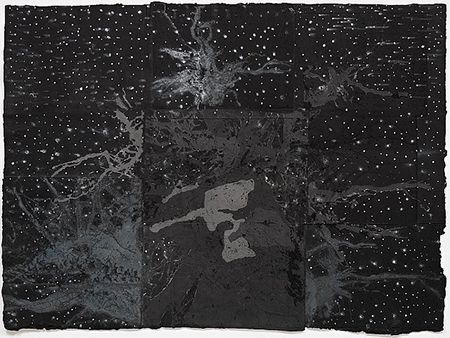
Continuing through October 3, 2015
If starting in a garage remains a classic origin story for a band or a business, growing up in a junkyard must be the parallel for a sculptor. Leonardo Drew spent his childhood playing in a dump near his family's home in Bridgeport, Connecticut, and created his first found object sculptures there. As a young artist in 1990's New York, Drew learned to polish — or rather, patina — flotsam and jetsam into sharp political weapons that cut to the heart of America's history and enduring struggles with race relations. New York Times critic Roberta Smith called Drew's densely textured installations featuring scrap metal and animal carcasses "an endless catastrophe seen from above."
Drew's latest contribution to this growing legacy is on view at Site Santa Fe right now, as part of their “Unsuspected Possibilities” exhibition, and this concurrent show “Leonardo Drew: Paper” possesses all the physical grit but none of the exposition. Despite their glistening, deliciously fungal layers, these works on paper have neat labels: “11P,” “13P,” “38P.” Drew deploys a wide array of paper-making techniques, building up textures by embossing and casting cotton paper pulp, and applying earthy pigments by hand. It's disorienting at first to witness Drew's orchestrated chaos removed from its message, like being stabbed by a knife to discover, to one’s relief, that it's a stage prop. Here are all of the tools of a powerful artist-activist, built from mush instead of rusty steel. When the initial shock subsides, process comes to the forefront. A watercolor can give birth to an oil painting and a piece of cast paper that practically congeals from the wall is a suitable study for a sculpture made with sharper edges. This is some very fine rubbish.
